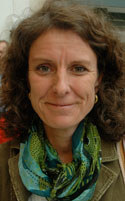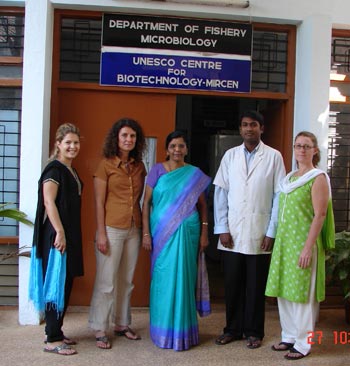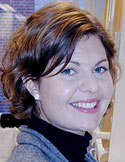SWEDISH SOUTH ASIAN STUDIES NETWORK
Department of Marine Ecology, Gothenburg University:
Postal Address: Box 461, SE 405 30, Göteborg,
Sweden
Visiting Address: Carl Skottsbergs gata 22 B
Web page: http://www.marecol.gu.se/
Web page for the MIRCEN (Microbial Resource Center) in Mangalore: http://www.mircenbiotech.com/
 Contact person: PhD Anna
Godhe, phone +46 (0)31 783 2709
Contact person: PhD Anna
Godhe, phone +46 (0)31 783 2709
Research at the department connected to South Asia:
Anna Godhe
defended her doctoral dissertation on ”Benthic
and pelagic dinoflagellate stages: environmental settings, cyst viability,
and molecular identification” on 18 October 2002.
Faculty opponent was Marianne Ellegaard, Associate Professor, Dept. of
Botany, University of Copenhagen, Denmark. Read
the abstract.
Since then she has been involved in a research project
on Toxic algae, their ecology, and about methods to develop identification
and detection of these algae, along the south-west coast of India, called
”Use of molecular techniques to study the
influence of benthic resting stages on the dynamics of harmful algal
along the south west coast of India”. The project has been
funded by a grant from Formas–Sida/Sarec (2005-07) and by a Swedish
Research Links grant from the Swedish Research Council (2006-08).
In India the collaborating partners have been Prof. Iddya
Karunasagar, and Ass. Prof Indrani Karunasagar
at Karnataka Animal Veterinary and Fisheries Science University.
 |
| Members of the project team in Mangalore, from left to right PhD candidate Karolina Härnström, Dr. Anna Godhe, Ass. Prof. Indrani Karunasagar, PhD candidate V. Saravanan and MFS student Åsa Lindskog from Göteborg University. |
Within the Karnataka Veterinary, Animal & Fisheries Sciences University, the Dept. of Fishery Microbiology has been become a prominent department. It has been recognized by UNESCO as a MIRCEN (Microbial Resource Center) in Marine Biotechnology. The mission of the Department is to impart education and carry out research in the area of Fishery Microbiology. There is an excellent combination of courses in both traditional microbiology and modern molecular biology.
Abstract of project: Several microalgae produce toxins
that can accumulate in shellfish, pose threat to human health, and cause
economical loss. Many of the microalgae form resting stages that can survive
in the sediment for decades. Resting stages are often referred to as seed
banks for future blooms, but we still lack information on the influence
of benthic life stages on phytoplankton dynamics.
Export of aquacultural products, mainly shrimps, is an important mean
of earning foreign exchange in India. Lately the export of shrimps has
declined due to several factors and government agencies are promoting
oysters and clams as side crops. Despite a long coastline there are few
scientist experienced in algal monitoring. This project encourages phycological
research in India. The specific aim of the study is to investigate the
significance of the resting stages and how important they are for the
onset of harmful algal blooms along the south-west coast of India. We
will use both microscopic and molecular techniques to determine the source
of phytoplankton blooms. In mesocosms, we will study the influence of
resting stage addition to phytoplankton community development. Molecular
methods will include primers targeting microsatellite loci in a bloom
forming phytoplankton species. We will obtain genetic fingerprints of
the benthic and planktonic populations sampled in field. Results will
contribute much needed information on the benthic-pelagic coupling and
the factors controlling phytoplankton blooms.
In November 2006, Dr. Godhe received SEK 2 340 000 as
a three-years grant (2007-09) from Sida's Developing Country Research
Council (U-landsforskningsrådet) and SEK 602 000 from the
Swedish Research Links programme for another
research project titled ”Inter-relation
between bacteria and phytoplankton blooms along the south-west coast
of India – applying advanced molecular techniques”.
Again, this project is carried out in collaboration with Prof.
Iddya Karunasagar at Karnataka Veterinary Animal and Fisheries Science
University in India.
Project abstract: Species within the bacterial genus Vibrio
are autochthonous in estuarine and seawater environments. The genus contains
a great diversity of pathogenic species, including V. cholerae. In India 25%
of all diarrhoeal diseases can be attributed to vibrio infections. Phytoplankton
are vital for the marine ecosystem. When the environmental settings are suitable,
algal blooms develop to high densities. About ten percent of all algal species
are harmful, and there are solid evidences of a global increase. We, and others
have found a strong correlation between dense algal biomass and high numbers
of vibrios. Our aim in this collaboration is to develop quantitative molecular
techniques for detection of vibrios and algae. We will study the development
of phytoplankton- and subsequent bacterial blooms in the natural marine habitat.
Thereafter we will investigate specific inter-relations between Vibrio spp and
phytoplankton in meso- and microcosms. Fate of pathogens in the environment will
without doubt reveal important and interesting results. Further, it is important
to define the platform for this inter-relation, to make models for correct assumptions
and risk analysis and thereby reduce unwanted impact on global health.
This project was also funded with SEK 942 000 as a Joint Formas – Sida/SAREC grant for research on sustainable development in developing countries, for the period 2007–09. More information about the South Asia related Formas–Sida/SAREC grants awarded in June 2007, with a project description in Swedish.
In December 2009, Anna Godhe received SEK 750 000 as a three-year International Collaborative Research Grant from the Swedish Research Links programme (funded by Sida and the Swedish Research Council) for the Indian Ocean project, now entitled ”Mitigating effects of harmful algal blooms in the Arabian Sea”. See the full list of South Asia related projects given Swedish Research Links grants 2009.
The research project will be carried out in collaboration with Dr. M N Venugopal at the the Karnataka Veterinary, Animal & Fisheries Sciences University.

 Karolina
Härnström has been a member in the project. Previously (2003-2004) she did a Minor Field Studies on the
same issue at the University of Agricultural Sciences in Mangalore,
India. After that she also completed a Masters degree in Biology
at the University of Kristianstad. On 25 September 2009, she defended her doctoral dissertation thesis, titled ”Bloom dynamics and population genetics of marine phytoplankton – Community, species and population aspects”. The faculty opponentwas Dr. Tatiana Rynearson, University of Rhode Island Graduate School of Oceanography, Coastal Institute, Narragansett, Rhode Island, USA. Her
main supervisor was Anna Godhe and her assistant supervisor Associate Professor Ann-Sofi Rehnstam-Holm at the Dept.
of Mathmatics and Natural Sciences, University of Kristianstad.
Karolina
Härnström has been a member in the project. Previously (2003-2004) she did a Minor Field Studies on the
same issue at the University of Agricultural Sciences in Mangalore,
India. After that she also completed a Masters degree in Biology
at the University of Kristianstad. On 25 September 2009, she defended her doctoral dissertation thesis, titled ”Bloom dynamics and population genetics of marine phytoplankton – Community, species and population aspects”. The faculty opponentwas Dr. Tatiana Rynearson, University of Rhode Island Graduate School of Oceanography, Coastal Institute, Narragansett, Rhode Island, USA. Her
main supervisor was Anna Godhe and her assistant supervisor Associate Professor Ann-Sofi Rehnstam-Holm at the Dept.
of Mathmatics and Natural Sciences, University of Kristianstad.
Dr.
Rehnstam-Holm was the recipient of the Swedish Research Links grants
that has been given to the project (more
information on the Swedish Research Links grants 2005).
In India Karolina
Härnström was supervised by Professor Karunasagar and Dr Karunasagar.
Abstract: The general aim of this thesis was to study marine phytoplankton dynamics at community, species and population level. Karolina has focused on the interaction between water mass and sediment, both in temperate waters and in a tropical area (Mangalore, India) investigating the importance of resting stages and small-scale hydrographical changes for the phytoplankton community structure as well as population genetics and microevolutional processes of population dynamics. The results from coastal south-west India show that benthic resting stages contribute to blooms by resuspension, germination, and proliferation as planktonic cells in the water column, and thus, the cells can influence the phytoplankton community in the water column. There can be an alternation of the species composition if a plankton community is seeded by resting stages or by planktonic cells, and geographically the strategies of seeding can differ within the same species. More information.
In 2010, Karolina Härnström spent a year as post-doc in Japan. She is now back in Sweden.![]()
During the academic year 2011/12, Dr. Arvindh Singh from the Physical Research Laboratory in Ahmedabad, India, will work at the department. He comes to Sweden on a post-doc scholarship granted by hte Swedish Institute (SI). ![]()
PhD candidate Maria Asplund also joined the project from from 2007. Maria holds a Masters degree in Marine Biology at the University of Göteborg. Her main supervisor is Anna Godhe and her assistant supervisor is Associate Professor Ann-Sofi Rehnstam-Holm.
In India Maria Asplund is supervised by Professor Karunasagar and Dr Karunasagar.
International workshop on “Safety of Shellfish from Harmful Algae and Biotoxins”
Anna Godhe, Ann-Sofi Rehnstam-Holm and their research students were involved in organising an International workshop on “Safety of Shellfish from Harmful Algae and Biotoxins” that was held at the UNESCO Microbial Resources Center (MIRCEN), Department of Fishery Microbiology, College of Fisheries, Mangalore, India, 21–25 January 2008. It focused on the problem with harmful algal blooms and shellfish toxicities – a global problem affecting safety of shellfish and international trade. It is estimated that about 2000 cases of shellfish toxicities occur annually with 15% mortality. Dr. Indrani Karunasagar was the Workshop Coordinator. The workshop was jointly sponsored by FAO, the Swedish International Development Agency (Sida) and UNESCO MIRCEN. More information about the Mangalore workshop.
SASNET - Swedish South Asian Studies Network/Lund
University
Address: Scheelevägen 15 D, SE-223 70 Lund, Sweden
Phone: +46 46 222 73 40
Webmaster: Lars Eklund
Last updated
2011-06-21
